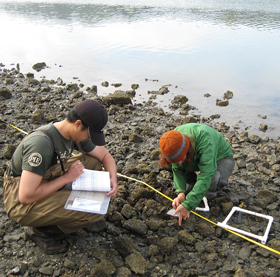
Identification of Critical Environmental Factors
A major focus of our science was to identify those environmental factors that most strongly affect Olympia oyster populations. We accomplished this through:
- laboratory experiments to test the relative role of climate change-related vs. other anthropogenic stressors, and to examine interactions between such stressors;
- field characterization of stressor levels (of both climate change-related and other anthropogenic stressors) and demographic responses to them in central California;
- expert assessments of oyster populations and environmental stressors in bays form southern California to British Columbia; and
- review of the literature on Olympia oysters and on environmental factors assessing other oyster species.
Site evaluations
Another emphasis of our science was to rigorously evaluate different sites within estuaries, to compare their restoration potential and conservation value for Olympia oysters. We did this by collecting data on oyster populations and environmental conditions at each site. In central California (San Francisco Bay and Elkhorn Slough), we collected these data consistently at 21 sites as a part of an intensive monitoring program design specifically to conduct these site evaluations. In southern California (San Diego and Newport bays) and southern Oregon (Coos Bay and South Slough), we used data available from previous studies designed for different purposes. With our experience from conducting these site evaluations, we developed a “do-it-yourself” tool that can be applied to new data and sites.




